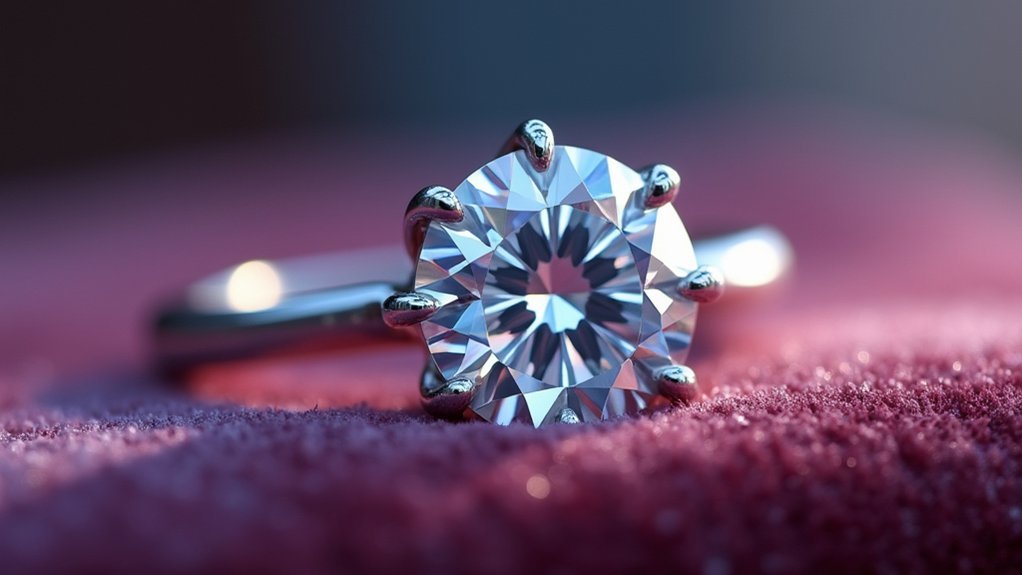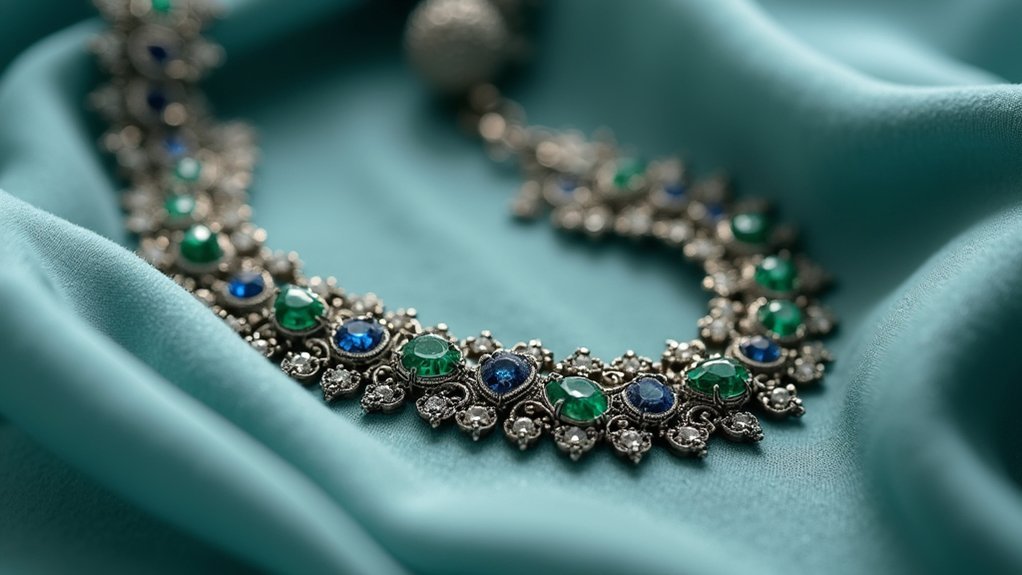You’ll capture every intricate detail of your jewelry with focus stacking, combining multiple shots at different focus points to achieve complete sharpness throughout the entire piece. This technique lets you shoot at ideal apertures like f/8 to f/11, avoiding diffraction while maintaining maximum lens performance. You’ll reveal crisp gemstone facets, delicate filigree work, and complex settings that would otherwise appear soft or blurry. Master this professional workflow to elevate your jewelry photography’s technical quality and visual impact.
Understanding Focus Stacking Fundamentals in Jewelry Photography

When photographing jewelry, you’ll quickly discover that achieving sharp focus across an entire piece presents a significant challenge. Traditional macro photography often leaves vital details blurry due to shallow depth of field.
Focus stacking solves this problem by combining multiple images captured at different focus points into one perfectly sharp photograph.
Focus stacking merges multiple images at varying focus points to create one completely sharp, detailed photograph.
This technique involves taking a series of shots while gradually adjusting your focus from the closest element to the farthest. You’ll start with the nearest part of your jewelry piece and systematically move through each focal plane. Each image captures a specific area in perfect sharpness.
Later, specialized software blends these images together, creating a final photograph where every detail remains crisp. This process guarantees that intricate clasps, gemstone facets, and delicate designs all appear with maximum clarity in your jewelry photography.
Achieving Superior Depth of Field Without Aperture Limitations
Traditional jewelry photography forces you into an impossible choice between stopping down your aperture for depth of field and maintaining ideal sharpness. When you shoot at f/16 or f/22, diffraction softens your entire image, defeating the purpose of capturing intricate details. Focus stacking eliminates this compromise by letting you shoot at your macro lens’s sweet spot—typically f/8 to f/11—while still achieving complete front-to-back sharpness.
| Traditional Method | Focus Stacking Method |
|---|---|
| Compromised sharpness at f/16+ | Best sharpness at f/8-f/11 |
| Limited depth of field control | Complete depth of field mastery |
| Diffraction reduces detail | Maximum detail preservation |
| Single focal plane | Multiple combined focal planes |
| Creative limitations | Enhanced creative possibilities |
You’ll capture every facet, setting detail, and surface texture with stunning clarity that’s impossible through conventional aperture adjustments alone.
Eliminating Lens Diffraction for Crystal-Clear Gemstone Details

When you stop down your aperture beyond f/11 or f/16 to achieve greater depth of field, you’re actually working against yourself due to lens diffraction that softens your gemstone’s intricate details.
This optical phenomenon occurs because smaller apertures force light to bend around the aperture blades, creating a halo effect that diminishes the crystal-clear sharpness necessary for showcasing a gem’s facets and internal characteristics.
Understanding how diffraction impacts your images and selecting ideal apertures becomes essential for maintaining the razor-sharp detail that luxury jewelry photography demands.
Understanding Lens Diffraction Effects
The subtle enemy of sharp jewelry photography often lurks in your camera’s aperture settings. Lens diffraction creates image softening that becomes increasingly problematic as you stop down beyond f/11. This optical phenomenon occurs when light waves bend around your aperture’s edges, degrading the fine details that make gemstones sparkle.
You’ll notice diffraction’s impact most severely when:
- Shooting intricate diamond patterns where individual facets lose their crisp definition
- Capturing delicate filigree work that appears mushy instead of razor-sharp
- Photographing textured metals where subtle surface details disappear into softness
Focus stacking eliminates this dilemma by letting you shoot at your lens’s sweet spot—typically f/8 to f/11—while still achieving broad depth of field.
You’ll capture every gemstone facet with crystal clarity while maintaining the thorough coverage your jewelry pieces demand.
Optimal Aperture Selection
Your lens performs its optical magic most effectively within a specific aperture range, and finding this sweet spot transforms your jewelry photography from merely acceptable to breathtaking.
Ideal aperture selection typically falls between f/8 to f/11, where your lens delivers maximum sharpness while minimizing lens diffraction that can soften intricate gemstone details.
At these apertures, you’ll capture crisp facets and enhance gemstone sparkle without compromising image quality.
However, this creates limited depth of field challenges when photographing complex jewelry pieces with varying heights and angles.
Focus stacking becomes essential here, allowing you to shoot at your lens’s sharpest aperture while ensuring complete coverage across your subject.
You’ll maintain crystal-clear details throughout the entire piece, from foreground elements to background features, creating professionally sharp images.
Shooting at Optimal Aperture Settings for Maximum Sharpness
Although many photographers assume any aperture will work for jewelry shots, achieving maximum sharpness requires strategic settings that balance optical performance with practical needs.
Your ideal aperture for macro jewelry photography sits between f/8 and f/11, where lens diffraction stays minimal while sharpness peaks.
The f/8 to f/11 aperture range delivers optimal sharpness by minimizing diffraction while maximizing your lens’s optical performance for jewelry photography.
Avoid these common aperture mistakes:
- Shooting wide open at f/2.8 – Creates dreamy backgrounds but sacrifices critical detail sharpness
- Choosing f/22 for maximum depth of field – Introduces heavy diffraction that softens your entire image
- Ignoring your lens’s sweet spot – Missing the aperture range where optical performance excels
When you implement focus stacking techniques, you’ll capture multiple sharp images at your lens’s ideal aperture, then blend them for complete depth of field coverage without compromising image quality.
Essential Equipment and Setup for Professional Results

You’ll need specific equipment to attain professional focus stacking results that showcase jewelry’s finest details.
Your camera and lens selection forms the foundation, while a sturdy tripod setup guarantees the stability that’s critical for capturing multiple identical frames.
A focus rail system completes your toolkit by allowing precise micro-adjustments between each shot in your stacking sequence.
Camera and Lens Selection
Three essential pieces of equipment form the foundation of successful jewelry focus stacking: a quality macro lens, a sturdy tripod, and a focus rail system.
Your camera lens choice dramatically impacts your results, with dedicated macro options like the Nikon 105mm or Canon 100mm delivering exceptional detail capture for intricate jewelry textures.
These specialized lenses excel at close-up work, revealing:
- Diamond facets that sparkle with crystalline precision
- Metal surfaces showing every polished curve and engraved detail
- Gemstone inclusions that tell each stone’s unique story
You’ll need to switch your camera to manual focus mode for consistent focus stacking results.
This prevents autofocus hunting between shots, ensuring each image maintains the same focal reference point throughout your sequence.
Tripod and Stability Setup
When camera movement destroys the precise alignment needed for focus stacking, a robust tripod becomes your most critical stability tool. You’ll need adjustable legs for precise positioning when capturing jewelry from different angles. A remote shutter release eliminates vibrations that could ruin your focus stacking sequence.
| Feature | Benefit |
|---|---|
| Weight capacity | Prevents wobbling during shooting |
| Quick-release plate | Speeds up focal point adjustments |
| Adjustable legs | Enables precise height/angle control |
| Remote trigger compatibility | Eliminates camera shake |
| Sturdy construction | Guarantees perfect shot alignment |
Your tripod must support your camera and lens weight to maintain stability throughout the entire focus stacking process. This foundation guarantees each frame aligns perfectly for seamless post-processing blending.
Focus Rail Systems
A focus rail system transforms your jewelry photography by enabling micro-precise camera movements that manual adjustments simply can’t achieve.
When you’re focus stacking intricate jewelry pieces, these systems deliver the consistency and repeatability essential for professional results.
Focus rail systems mount directly to your tripod, eliminating camera shake while you make incremental adjustments along the focus plane.
The built-in measurement markings help you track each movement, ensuring seamless shifts between focus points.
- Watch gemstone facets emerge with razor-sharp clarity as you methodically adjust through each focal plane
- Feel confident knowing your camera remains perfectly aligned while capturing every intricate detail
- Experience enhanced depth of field that reveals complex textures and designs previously lost to shallow focus
This precision equipment greatly elevates your jewelry photography’s technical quality and visual impact.
Step-by-Step Focus Stacking Workflow and Software Processing

Once you’ve set up your camera and lighting, you’ll need to capture a systematic series of images with different focus points to create your focus stack.
Begin your focus stacking workflow by shooting from the closest jewelry detail to the furthest, ensuring each image overlaps with the previous one. Use a focus rail for precise adjustments between shots to maintain consistency.
Import your images into software like Helicon Focus or Photoshop using the “Load Files into Stack” feature.
Apply “Auto-align” to correct minor camera shake, then use “Auto-blend” to merge the images seamlessly. This creates sharp focus across your entire product.
Complete your workflow with background cleanup and additional sharpening to enhance the final presentation quality.
Frequently Asked Questions
What Is the Point of Focus Stacking?
You’ll combine multiple images at different focus points to create one sharp photo throughout. This overcomes shallow depth of field limitations, ensuring every detail stays crisp while maintaining ideal aperture settings.
What Camera Setting Is Best for Jewelry Photography?
You’ll want manual mode with f/8-f/11 aperture for ideal sharpness, ISO 100-200 for minimal noise, and use a macro lens like Nikon’s 105mm with tripod for stability.
What Are the Benefits of Stacking Photos?
You’ll achieve sharper images across your entire jewelry piece by combining multiple focus points. Stacking eliminates blurry edges, enhances gemstone sparkle, and lets you use ideal aperture settings while maintaining creative control.
What Is Focus Stacking a Photographic Technique to Achieve?
Focus stacking’s a photographic technique you’ll use to achieve maximum sharpness throughout your entire image. You’ll capture multiple shots at different focus points, then blend them together for complete front-to-back clarity.
In Summary
You’ve discovered how focus stacking transforms your jewelry photography by delivering razor-sharp details across every surface. You’re no longer constrained by aperture limitations or diffraction issues that plague single-shot techniques. You can capture intricate gemstone facets, metal textures, and delicate engravings with stunning clarity. Master this workflow, and you’ll consistently produce professional-grade images that showcase jewelry’s true beauty. Your clients will notice the difference immediately—every piece tells its complete story through perfect focus.





Leave a Reply